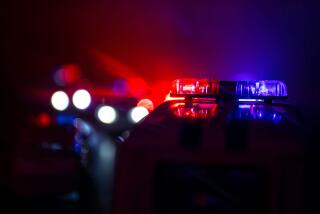Speedier 911 Cellular Call Response May Be Put on Hold
- Share via
WASHINGTON — A long-awaited system that would provide cellular phone users with more rapid emergency response times could be delayed as the industry seeks government permission for more time to deploy the technology.
A system for tracking 911 calls from wireless phones within a two- to three-mile radius was to have been in place by April 1998, with a more precise system to be running by Oct. 1, 2001. But the initial deadline hasn’t been met, and fast-changing technology has some carriers and public safety officials balking at paying billions of dollars for a second-generation system that could quickly be leapfrogged by less costly solutions.
It currently takes police and fire crews about 10 times longer to locate a wireless phone caller than the average five- to seven-minute response time to 911 calls from land-line phones in Los Angeles and other big cities, said Jack Keating, president of the Assn. of Public Safety Communications Officials, a trade group based in South Daytona, Fla.
In an effort to shorten the wait, the Federal Communications Commission in 1996 approved rules requiring the industry to install expensive technology aimed at ensuring that safety officials can pinpoint the locations of cellular phone users dialing 911. The agency was spurred into action by several widely publicized cases of users left stranded because rescue crews were unable to locate them quickly.
But some wireless carriers and public safety officials have petitioned the FCC to push back its October 2001 deadline because of concerns about spending the estimated $2 billion to $4 billion for upgrading the tracking network at a time when new technologies are being developed and prices are dropping.
Upstart companies such as SnapTrack say they have developed technology that would involve installing transmitters in users’ phones that would be used to locate callers via a network of global positioning satellites, or GPS. But they say they need additional time for the network to be upgraded to work with the phones and for distribution of newer handsets to the nation’s 76 million cellular phone users.
“We strongly favor a choice of technologies,” said Jonathan Marshall, a spokesman for cellular phone carrier AirTouch. “The cost of the technology is going to be passed on regardless, so we want to avoid sticking customers with an extra-large charge.”
But companies that use a different tracking technology, located in cellular phone towers rather than in handsets, say wireless carriers could easily meet the FCC’s deadline if ordered to do so.
“It would be a disservice to the consumer to wait,” said Paul Brunato, a spokesman for U.S. Wireless, which uses the tower tracking technology. “The Oct. 1, 2001, deadline can be met. Not to implement the systems would be to put public safety on the back burner . . . and put people’s lives at risk.”
AT&T; Wireless Services spokesman Dan Youmans said the FCC should stand firm, saying, “We are planning on being ready by the Oct. 1 deadline.”
Advocates of the handset solution say it would cost $7 to $10 to install the technology in each phone, as opposed to $10,000 to $30,000 needed to retrofit each cell tower with tracking technology.
An underlying factor in the debate involves the varying networks linked to the nearly half a dozen incompatible wireless systems operating in the United States. The chief division has been between CDMA, or code division multiple access, technology developed by Qualcomm and used by wireless operators such as AirTouch and BellAtlantic Mobile, and time division multiple access technology embraced by wireless operators such as Sprint Spectrum and AT&T; Wireless Services.
The FCC called on the industry to complete deployment of the first phase by April, enabling public safety officials to dial the 911 caller and tell emergency crews the location of the cell site receiving the call.
But because of funding problems and other red tape, only a handful of public safety departments have installed the necessary equipment to receive the wireless data, experts say.
It wasn’t until earlier this year, for instance, that the California Highway Patrol--in conjunction with other state and local officials--completed a 911 wireless emergency location system testing in a 63-square-mile area in the San Gabriel Valley. The system provided 911 operators with caller ID, but was less successful in pinpointing callers’ location. Operators could only place callers within a two- to three-mile radius.
The FCC has asked for comments and will study them over the next few weeks but has not indicated whether it will extend the deadline.
*
Times staff writer Jube Shiver Jr. can be reached at jube.shiver@latimes.com.






